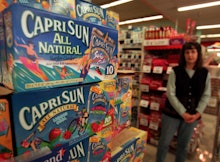What Your Food Label Says vs. What It Actually Means

Confused on what "all natural" and "organic" really mean? You're not alone.
Revamped food labels are all the rage in recent months, but they're often difficult to understand. There's a lot riding on that little "organic" sticker — and a lot you probably don't know.
Recent news has only made understanding these food labels harder. In February, the FDA proposed a new nutrition label that would put calorie counts in large typeface and change portion sizes to reflect how much Americans actually eat — who eats half a cup of ice cream?). A Vermont law signed this month would require food companies to label products with genetically modified ingredients; Connecticut and Maine have similar laws that would go into effect if enough surrounding states do the same. These labels often look daunting and have a sense of importance to them.
The reality is that food labels mean very little, and they are often more confusing than they are elucidating.
"All natural"
What it says: According to its website, the "FDA has not developed a definition for use of the term natural or its derivatives." They also include this little note, however: "The agency has not objected to the use of the term if the food does not contain added color, artificial flavors, or synthetic substances."
What it means: The FDA doesn't regulate what foods it considers natural, but that might actually be a good thing, since defining "natural" after 12,000 years of domesticated agriculture could get a bit tricky. In that time, we've drastically altered the things we eat, starting with plant breeding all the way up to the more precise genetic modification that many farmers now use to create fruits, vegetables and animals with the most desirable characteristics.
Recently, several people attempted to sue food companies that had used the term "natural" on some of their products when they found out they contained genetically modified ingredients. That means, quite simply, that 75% of processed foods currently on grocery store shelves would get a new sticker.
It's time to ditch the "natural" obsession and get comfortable with the fact that most of our food is a product of hundreds of years of science.
"Free range"
What is says: "Producers must demonstrate to the FDA that the poultry has been allowed access to the outside," writes the USDA.
What it means: Before we get into the nitty gritty details of the labels on beef and chicken, let's talk about factory farming, or how the world gets the vast majority of its meat. Even products labeled "free range" are often produced from animals that are raised this way, including 81% of cows, 73% of sheep, 60% of pigs, and 50% of chickens. a factory farm is a livestock facility where cows and sheep are raised in confinement, fed a corn-based diet at an early age to increase the amount of fat in their muscle tissue and then "finished" on a diet of dried grain, corn gluten and soy hulls to make them gain weight as fast as possible. Most factory-farmed cattle, for example, are killed between 14 and 17 months of age, but many industrial farms have experimented with feeding techniques that accelerate this process.
A producer who wants to label her chicken "free range" must simply show that the animal had "access to the outside," even if only for a few minutes each month. And while that definition at least ensures that chicken see some fresh air in their lifetimes, it doesn't apply to any other animal.
"Grassfed"
What it says: "The diet shall be derived solely from forage consisting of grass, forbs, browse or cereal grain crops in the vegetative (pre-grain) state. Animals cannot be fed grain or grain byproducts and must have continuous access to pasture during the growing season." (USDA)
What it means: As opposed to food items with the labels above, the USDA actually certifies foods with the "grassfed" sticker, meaning they visit the farm each year to ensure it is following the agency's guidelines. Fortunately for those companies, the rules aren't too strict. Although grassfed cows and sheep must be fed a diet "derived solely from forage consisting of grass," the animals don't have to find their food in the wild. Farmers can simply replace the traditional grain food they keep on barn shelves with "grass" — which in this case happens to also include hay, bale, silage and crop residue. At least the animals get access to pasture for the majority of the growing season.
"Organic"
What it says: "Organic indicates that the food or other agricultural product has been produced through approved methods that integrate cultural, biological, and mechanical practices that foster cycling of resources, promote ecological balance and conserve biodiversity. Synthetic fertilizers, sewage sludge, irradiation and genetic engineering may not be used."
What it means: The strictest of the labels, the "organic" sticker carries an inkling of weight — at least when it comes to meat and dairy. Producers who use the label must let animals graze for at least four months during the grazing season specific to the climate where they live. More specifically, organic meat must come from animals whose diet consists of at least 30% grass eaten during grazing season. The animals also cannot be fed any growth hormones or antibiotics; their feed can't include any of these chemicals either.
But what about organic produce? As it turns out, the term "organic" is not synonymous with pesticide-free.
Organic farmers often use pesticides more liberally than conventional ones. The difference is that the pesticides organic farmers use are "natural" as opposed to synthetic, meaning made by a person. But decades of research has shown that 'natural' pesticides are linked with just as many health risks as human-made ones.